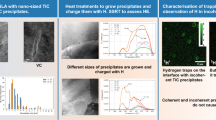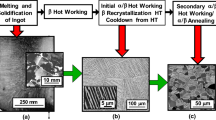Abstract
Cumulative zirconium and zirconium alloy creep data over a broad range of stresses (0.1 to 115 MPa) and temperatures (300 °C to 850 °C) were analyzed based on an extensive literature review and experiments. Zirconium obeys traditional power-law creep with a stress exponent of approximately 6.4 over stain rates and temperatures usually associated with the conventional “five-power-law” regime. The measured activation energies for creep correlated with the activation energies for zirconium self-diffusion. Thus, dislocation climb, rather than the often assumed glide mechanism, appears to be rate controlling. The common zirconium alloys (i. e., Zircaloys) have higher creep strength than zirconium. The stress exponents of the creep data in the five-power-law regime were determined to be 4.8 and 5.0 for Zircaloy-2 and Zircaloy-4, respectively. The creep strength of irradiated Zircaloy appears to increase relative to unirradiated material. It was found that the creep behavior of zirconium was not sensitive to oxygen in the environment over the temperature range examined.
Similar content being viewed by others
References
R.C. Ecob and A.T. Donaldson:J. Nucl. Mater., 1985, vol. 132, pp. 110–25.
V. Fidleris:J. Nucl. Mater., 1968, vol. 26, pp. 51–76.
V. Fidleris and C.D. Williams:Electrochem. Technol., 1966, vol. 4, pp. 258–67.
A.J. Ardell and O.D. Sherby:Trans. TMS-AIME, 1967, vol. 239, pp. 1547–56.
E.R. Gilbert, S.A. Duran, and A.L. Bement:Applications-Related Phenomena for Zirconium and Its Alloys, ASTM STP 458, ASTM, Philadelphia, PA, 1968, pp. 210–25.
S.R. MacEwen, R.G. Fleck, E.T.C. Ho, and O.T. Woo:Metall. Trans. A, 1981, vol. 12A, pp. 1751–59.
M. Pahutova and J. Cadek:Mater. Sci. Eng., 1973, vol. 11, pp. 151–62.
I.M. Bernstein:Trans. TMS-AIME, 1967, vol. 239, pp. 1518–22.
B. Ramaswami and G.B. Craig:Trans. TMS-AIME, 1967, vol. 239, pp. 1226–31.
N. Prasad, G. Malakondaiah, and P. Rama Rao:Trans. Ind. Inst. Met., 1989, vol. 42 (supplement), pp. S165–74.
H. Siethoff and K. Ahlborn:Scripta Metall., 1987, vol. 21A, pp. 1439–44.
T.A. Hayes, M.E. Kassner, and R.S. Rosen:Metall. Mater. Trans. A, 2002, vol. 33A, pp. 337–43.
W. Blum and W. Maier:Phys. Status Solidi, 1999, vol. 171, pp. 467–74.
S. Fujishiro and D. Eylon:Scripta Metall., 1977, vol. 11, pp. 1011–16.
C. Quesne, C. Duong, F. Charpentier, J. Fries, and P. Lacombe:J. Less-Common Met., 1979, vol. 68, pp. 133–42.
S. Raff and R. Meyder:Water Reactor Fuel Element Performance Computer Modeling, Applied Science Publishers, London, 1983, p. 253.
S. Fujishiro and D. Eylon:Scripta Metall., 1977, vol. 11, pp. 1011–16.
M.E. Kassner and M.-T. Perez-Prado:Fundamentals of Creep in Metals and Alloys, Elsevier, Oxford, 2006.
M.T. Pérez-Prado, S.R. Barrabes, M.E. Kassner, and E. Evangelista:Acta Mater., 2005, vol. 53, pp. 581–91.
G.A. Henshall, M.E. Kassner, and H.J. McQueen:Metall. Mater. Trans. A, 1992, vol. A23, pp. 881–89.
M. Lubbehusen, K. Vieregge, G.M. Hood, H. Mehrer, and C. Herzig:J. Nucl. Mater., 1991, vol. 182, pp. 164–69.
J. Horvath, F. Dyment, and H. Mehrer:J. Nucl. Mater., 1984, vol. 126, pp. 206–14.
F. Dyment and C.M. Libanati:J. Mater. Sci., 1968, vol. 3, pp. 349–59.
G.B. Fedorov and F.I. Zhomov:Met. Metalloved. Chistyh. Metall., 1959, vol. 1, p. 161.
E.V. Borisov, Yu. G. Godin, P.L. Gruzin, A.J. Evstyukhin, and V.S. Emel’yanov:Metall. Metallogr., 1958, p. 291.
V.S. Lyashenko, V.N. Bykov, and L.V. Pavlinov:Phys. Metall. Metallogr., 1959, vol. 8, pp. 40–46.
P. Flubacher: “Selbst-Diffusionsversuche in α-Zirkon,” EIR-Bericht No. 49, Eidg. Institut für Reaktorforschung, Würenlingen, Switzerland, 1963.
G.M. Hood:Defect Diff. Forum, 1993, vols. 95–98, pp. 755–74.
W. Frank:Defect Diff. Forum, 1989, vols. 66–69, pp. 387–94.
E. Forlerer de Svarch and C. Rodriguez:J. Nucl. Mater., 1991, vol. 185, pp. 167–73.
T.A. Hayes: Ph.D. dissertation, University of California, San Diego, CA, 2004.
J.J. Holmes:J. Nucl. Mater., 1964, vol. 13, pp. 137–41.
R.B. Jones:J. Nucl. Mater., 1966, vol. 19, pp. 204–07.
G. Kaspar, M. Peehs, E. Steinberg, and H. Schonfeld:Trans. 8th Int’L SMiRT Conf., North Holland, Amsterdam paper C1/8, 1985, pp. 51–7.
D.S. Wood and B. Watkins:J. Nucl. Mater., 1971, vol. 41, pp. 327–40.
K.M. Rose and E.D. Hindle:Zirconium in the Nuclear Industry, ASTM STP 633, ASTM, Philadelphia, PA, 1977, p. 24.
P.A. Ross-Ross and C.E.L. Hunt:J. Nucl. Mater., 1968, vol. 26, pp. 2–17.
B.D. Clay and G.B. Redding: “Creep Rupture Properties of Alpha-Phase Zircaloy Cladding Relevant to the Loss-of-Coolant Accident,” CEGB Report No. RD/B/N 3187, 1975, Berkeley Nuclear Laboratories Report No. CEGB-RD/B/N 3782, Berkeley, England, 1976.
B.D. Clay and G.B. Redding:J. Br. Nucl. Ener. Soc., 1976, vol. 15, pp. 253–56.
N. Prasad, G. Malakondaiah, and P. Rama Rao:Scripta Metall., 1992, vol. 26, pp. 541–43.
N. Prasad, G. Malakondaiah, K. Muraleedharan, and P. Rama Rao:J. Nucl. Mater., 1988, vol. 158, pp. 30–41.
C.E. Coleman:J. Nucl. Mater., 1972, vol. 42, pp. 180–90.
B. Burton, A.T. Donaldson, and G.L. Reynolds:Zirconium in the Nuclear Industry, ASTM STP 681, ASTM, Philadelphia, PA, 1979, pp. 561–85.
G.E. Lucas and R.M.N. Pelloux:Nucl. Technol., 1981, vol. 53, pp. 46–57.
G.E. Lucas and R.M.N. Pelloux:Metall. Trans. A, 1981, vol. 12A, pp. 1321–31.
G.E. Lucas, M. Surprenant, J. DiMarzo, and G.J. Brown:J. Nucl. Mater., 1981, vol. 101, pp. 78–91.
P.J. Pankaskie: “Creep Properties of Zircaloy-2 for Design Application,” HW-SA-2803, Hanford Atomic Products Operation, Richland, WA, 1962.
L.G. Bell:Can. Metall. Q., 1963, vol. 2, pp. 119–42.
F. Tinti:Nucl. Technol., 1983, vol. 60, pp. 104–13.
E.R. Gilbert and B. Mastel:ANS Trans., 1969, vol. 12, pp. 132–33.
Y. Matsuo:J. Nucl. Sci. Technol., 1987, vol. 24 (2), pp. 111–19.
F. Povolo and A.J. Marzocca:J. Nucl. Mater., 1981, vol. 97, pp. 323–32.
A.T. Donaldson and R.C. Ecob:Scripta Metall., 1985, vol. 19, pp. 1313–18.
C.C. Busby and K.B. Marsh: “High Temperature Time-Dependent Deformation in Internally Pressurized Zircaloy-4 Tubing (LBWR Development Program),” Bettis Atomic Power Laboratory Report No. WAPD-TM-1043, Westinghouse Electric Corporation, Pittsburgh, PA 1974.
C.C. Busby and L.S. White: “Some High Temperature Mechanical Properties of Internally Pressurized Zircaloy-4 Tubing,” Bettis Atomic Power Laboratory Report No. WAPD-TM-1243, Westinghouse Electric Corporation, Pittsburgh, PA 1976.
A.M. Garde, H.M. Chung, and T.F. Kassner:Acta Metall., 1978, vol. 26, pp. 153–66.
A.M. Garde:J. Nucl. Mater, 1979, vol. 80, pp. 195–206.
H.M. Chung, A.M. Garde, and T.F. Kassner: “Mechanical Properties of Zircaloy Containing Oxygen,” Argonne National Laboratory Report No. ANL-76-121, Argonne National Laboratory, Argonne, IL, 1978.
G. Brun, J. Pelchat, J.C. Floze, and M. Galimberti:Zirconium in the Nuclear Industry, ASTM STP 939, ASTM, Philadelphia, PA, 1987, pp. 597–616.
M. Mayuzumi and T. Onchi:J. Nucl. Mater., 1990, vol. 175, pp. 135–42.
M. Mayuzumi and T. Onchi:J. Nucl. Mater., 1990, vol. 171, pp. 381–88.
K.L. Murty:JOM, 1999, vol. 51, pp. 32–39.
K.L. Murty, B.V. Tanikella, and J.C. Earthman:Acta Metall. Mater, 1994, vol. 42, pp. 3653–61.
K.L. Murty:Trans. Ind. Inst. Met., 2000, vol. 53, pp. 107–20.
Y.-S. Kim:J. Nucl. Mater., 1997, vol. 250, pp. 164–70.
J.H. Choe and J.H. Hong:J. Kor. Inst. Met., 1984, vol. 22, pp. 613–20.
Y.-K. Park, T.-S. Kim, J.-H. Choi, and M.-Y. Wee:J. Kor. Inst. Met. Mater., 2000, vol. 38, pp. 624–28.
H.E. Rosinger, P.C. Bera, and W.R. Clendening: “The Steady State Creep of Zircaloy-4 Fuel Cladding from 940 to 1873 K,” AECL-6193, Atomic Energy of Canada Limited, Whiteshell Nuclear Research Establishment, Pinawa, Manitoba, Canada, 1978.
G. Porsch, J. Fleisch, and B. Heits:Nucl. Technol., 1986, vol. 74, pp. 287–98.
M. Peehs and J. Fleisch:J. Nucl. Mater., 1986, vol. 137, pp. 190–202.
R.E. Einziger, H. Tsai, M.C. Billone, and B.A. Hilton: “Examination of Spent Fuel Rods after 15 Years in Dry Storage,” Report No. NUREG/CR-6831, ANL-03/17, Argonne National Laboratory, Argonne, IL, 2003.
R.E. Einziger, S.D. Atkin, D.E. Stellrecht, and V. Pasupathi:Nucl. Technol., 1982, vol. 57, pp. 65–80.
R.E. Einziger and R. Kohli:Nucl. Technol., 1984, vol. 67, pp. 107–23.
W. Goll, H. Spilker, and E. Toscano:J. Nucl. Mater., 2001, vol. 289, pp. 247–53.
C. Pescatore and M.G. Cowgill: “Temperature Limit Determination for the Inert Dry Storage of Spent Nuclear Fuel—Final Report,” EPRI TR-103949, Brookhaven National Laboratory, Upton, NY, 1994.
P.J. Henningson, J.T. Willse, B. Cox, M.G. Bale, K.L. Murty, and W.A. Pavinich: “Cladding Integrity under Long Term Disposal,” Framatome Technologies Report No. 51-1267509-00, 1998.
R.L. Keusseyan, C.P. Hu, and C.Y. Li:J. Nucl. Mater., 1979, vol. 80, pp. 390–92.
T.A. Hayes, R.S. Rosen, and M.E. Kassner:J. Nucl. Mater., in press.
Author information
Authors and Affiliations
Rights and permissions
About this article
Cite this article
Hayes, T.A., Kassner, M.E. Creep of zirconium and zirconium alloys. Metall Mater Trans A 37, 2389–2396 (2006). https://doi.org/10.1007/BF02586213
Received:
Issue Date:
DOI: https://doi.org/10.1007/BF02586213




